How to connect a toilet to a sewer system: a review of installation technologies for all types of toilets
The process of installing plumbing is the same in a house, apartment or bathhouse. Once you figure out how to connect the toilet to the sewer, you can do it in any necessary place.Agree, in the end you will be able to save a lot of money, especially if you have to install more than one plumbing unit.
We will help you understand the issue. Below are basic diagrams and step-by-step instructions for connecting a toilet to a sewer system, which it is advisable to study before purchasing plumbing fixtures.
Visual photo instructions and explanatory videos will help you better understand the intricacies of the process and determine the sequence of actions in a given situation.
The content of the article:
Installation tool kit
The process of connecting a toilet to a sewer requires a preliminary assessment of the necessary materials. The choice of plumbing and connecting fittings depends on the type of sewer riser supply, the intended installation location of the toilet and its type.
In addition to the equipment itself, when toilet installation do it yourself you may need:
- Sewer corrugation.
- Plastic corners and adapters.
- Eccentric cuff.
- Silicone.
- Rubber seals and adapters.
- A saw for plastic pipes or a regular hacksaw for metal.
- Tape measure, pencil, hammer.
- Tools for dismantling old sewerage elements and fixing the toilet to the floor.
To remove old cast iron pipes, you may need a professional hammer drill and grinder, but in such advanced cases it is better to invite specialists with their own tools for dismantling.
Options for toilet and sewer connections
The size of the toilet outlet is standardized, but it may not coincide with the diameter of the sewer pipe. In addition, the connecting pipes may additionally include sewer lines from other parts of the house of various sizes. Therefore, it is important to find out in advance what adapters, cuffs and fittings will be needed.
Types of toilet releases
The range of plumbing products in stores is represented by hundreds of different models, but they can only have three types of outlet design:
- Vertical.
- Horizontal.
- Oblique.
Depending on the design features, the outlet pipe is connected to the toilet bowl perpendicularly, parallel or at an angle to the floor.
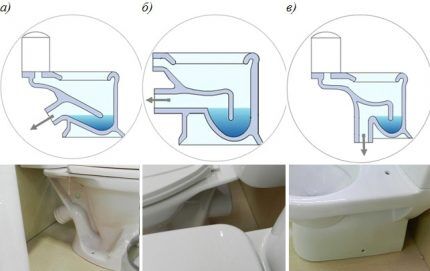
The vertical type of toilet is common in the EU and the USA. However, in our new buildings we are increasingly using a vertical connection scheme, as it is less problematic.
Types of connecting pipes
If the design of the sewer system or the location of the toilet does not provide for direct connection of pipes, then it is necessary to consider the purchase of such connecting parts as corrugated cuffs, eccentric connections, plastic corners and bends, and vent pipes.
Corrugated pipes. They are convenient to use when the alignment of the connecting pipes is not maintained, because the corrugation can be bent in any direction and at any angle.
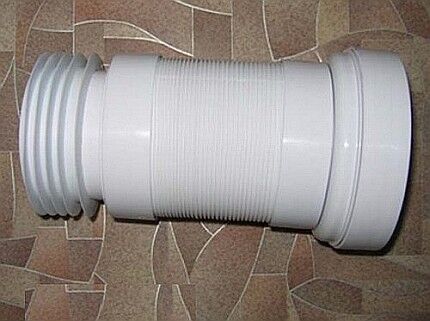
Eccentric cuffs. Transitional rubber eccentrics have the form of two branches, whose axes are shifted relative to each other by a certain distance.
Before going to the store, you need to measure the displacement between the axes of the toilet outlet and the sewer hole to select the appropriate eccentric model.
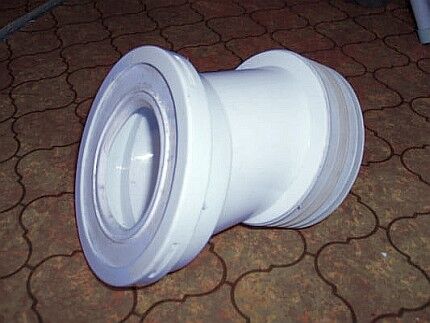
Plastic corners and bends. These parts are used in places where installation of corrugation is impossible or undesirable. Their disadvantage is their rigidity, which often leads to leakage in the presence of minor distortions.
Unlike drain pipes, plastic sewer pipes can be cut to fit the length.
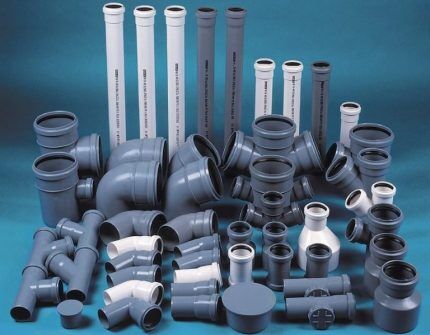
Fan pipes. Indispensable in places where there is a risk of water seal failure. If the capacity of the sewer riser is insufficient, water may be drawn into it from the siphon. As a result, the water seal disappears and an unpleasant putrid smell appears from the toilet.
In such cases, to the riser itself or the pipe connecting it to the toilet connect the drain pipe with a valve that opens when the water is drained and sucks in air from the room or street, preventing the water seal from breaking.
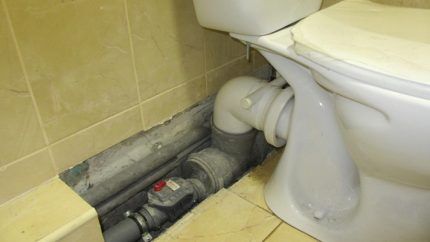
To enhance the reliability of sewer connections, it is advisable to apply a layer of waterproof sealant everywhere, which will prevent leaks in the event of a weakening of the rubber seal.
Dismantling cast iron elements
To dismantle cast iron elements and cement left over from old plumbing, you will need a hammer, a pry bar and a flat-head screwdriver. The outlet of older toilets is often cemented into a cast iron elbow.
Often the only way to dismantle is to break the ceramic pipe with a hammer.
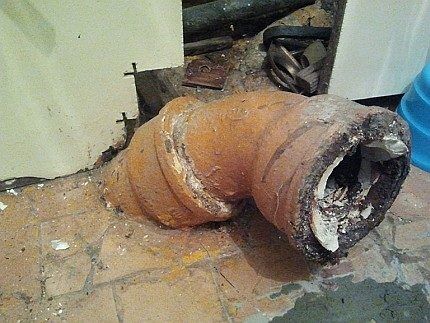
After removing the toilet, you need to tap the cast iron pipe on all sides and begin removing cement and deposits from its internal surface. To do this, use a hammer and a screwdriver, and large pieces are removed with a pry bar.
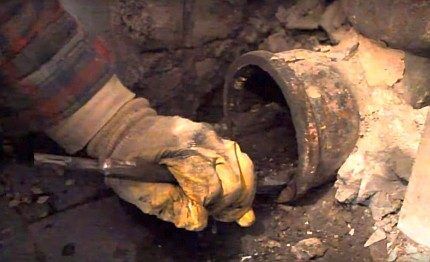
To completely clean the pipes of rust and deposits, you can moisten them with toilet cleaner and then scrape them off with a wire brush.
Complete cleaning with a rag. These manipulations must be done wearing special protective gloves. It is important that the first 5 cm of the internal space of the cast iron pipe are smooth, as they will ensure the tightness of the future connection.
Instructions for connecting a toilet with corrugation
The basic steps for connecting a toilet to a sewer will be discussed using a common version with using corrugated pipe. Installation of corrugation is the basic and most common type of connection between a toilet and a sewer system.
When deciding to choose a corrugated pipe, you need to be aware of the positive and negative features of this design.The remaining installation options follow the same scheme, but with some differences.
The positive properties of corrugation include:
- Low cost.
- Ability to lengthen and bend.
- No problems with hole alignment.
- Can be used as a temporary connection.
Among the disadvantages of corrugated pipes are the following:
- The walls are easily damaged during installation.
- Periodic cleaning is required on low slopes.
- Sagging during long-term use.
- Difficulty in cleaning the external surface from dust.
The final decision on the installation of corrugation is made after taking into account all the above-described features.
Corrugated connections are installed on toilets with oblique and horizontal flushes. Before purchasing a product, you must measure the approximate distance between the toilet and the sewer hole. The length of the corrugation must be at least 1/3 longer than this value.
Step one: fitting
At the beginning of the procedure for connecting the toilet to the sewer, it is necessary to try out the compatibility of the design. To do this, take a rubber seal and insert it into the sewer hole, having previously lubricated the joint with a thick layer of silicone. Then push the rubber tip of the corrugation into the sewer drain.
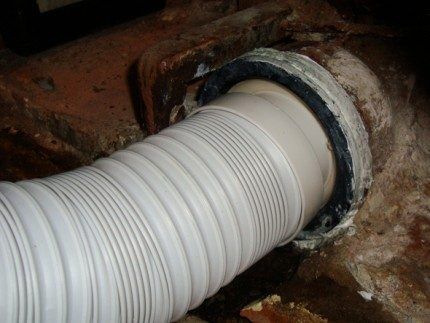
After inserting the corrugated pipe, at subsequent stages of installation, it is not advisable to twist it until the silicone has completely dried.
The next step is to take the toilet and install it in its planned permanent place. Sit on it, checking that it is stable and does not rock.If the toilet is unstable, you will need to level the floor or install expansion stands to correct the unevenness of the tiles.
If the toilet is stable, then it is necessary to connect a corrugated pipe to its pipe without lubricating it with silicone. After this, you need to pour three buckets of water into the toilet and, after waiting a minute, check both holes of the corrugation for leaks.
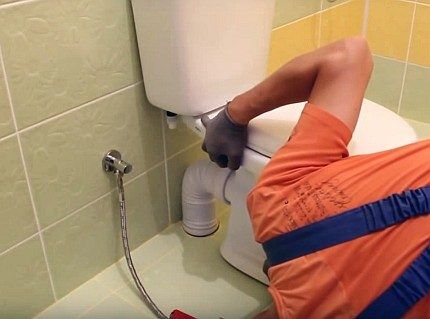
If there are leaks, it is necessary to remove the corrugation, check the correct location of the rubber seals and once again connect the parts along their axes.
If there are no leaks, then you need to mark with a marker where the toilet is attached to the floor.
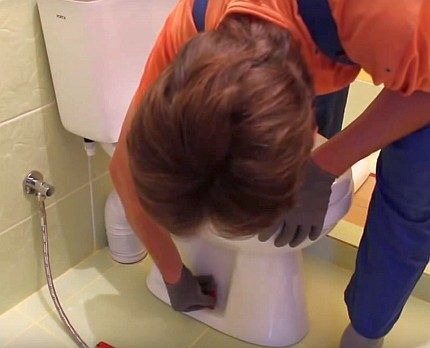
After the measurements, it is necessary to disconnect the corrugation from the toilet and secure it so that there is no distortion at the junction with the sewer hole. Move the toilet aside.
Step two: fixing the toilet
In the designated places, we drill holes in the floor with a drill, insert dowels into them and place the toilet in a permanent place.
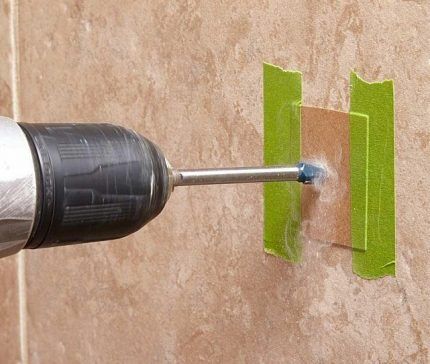
After installing the toilet fix it to the floor. Then you need to sit on the toilet and move your center of gravity in different directions for a minute. After this, tighten the fixing screws again and put decorative caps on them.
Before installation, most installers advise treating the joint between the toilet and the tiles with waterproof silicone. But they do not take into account the complexity of subsequent cleaning of the premises. After a few months of cleaning the floor, the silicone sealant will peel off from the joint and a gap will form.
Therefore, before installing the toilet in place, you need to turn it over and lubricate the perimeter that will come into contact with the tiles with silicone. After this, you should put the toilet and screw it on, and seal the gap between it and the floor with a sealant on a waterproof cement base, which will not be destroyed when the bathroom is wet cleaned.
The features of installing a toilet on a wooden floor are written in this article.
Step three: sewer connection
After installing the toilet, you need to lubricate the inner surface of the rubber corrugation with silicone and pull it onto the toilet pipe.

After installing the corrugation, you must wait 2 hours until the silicone hardens and only then proceed to the next step.
Step Four: Testing
After the sealant has dried, you can test the toilet by sitting on it and performing 2-3 full flushes. If after 5 minutes nothing has leaked, then you can screw on the tank with the toilet seat and use the plumbing.
In case of a small drop-shaped leak, you should completely remove the water from the toilet bowl and remove the corrugation from it. After this, re-lubricate the rubber band of the corrugated pipe with silicone and pull it onto the toilet pipe. You can also additionally lubricate the joint with sealant from the outside.
At this point, connecting the toilet to the sewer using a corrugated pipe can be considered complete.
Connecting the toilet with plastic elbows
Unlike corrugated pipe, plastic elbows do not have flexibility. But if the sewer line was originally planned for a specific toilet model, then rigid outlets are more preferable because of their durability and problem-free nature.

The main steps for connecting a toilet to a sewer with plastic elbows are similar to those for installation using corrugation.
Basic rules for using rigid connection elements:
- All connecting pipes are lubricated with silicone before installation in the holes.
- Excessively long pipes can be cut with a hacksaw.
- It is necessary to exclude any distortions.
- Horizontal 90 degree bends should be avoided due to the possibility of clogging.
The disadvantage of budget plastic outlets is their gray color, which does not at all harmonize with the snow-white toilet. White models are much more expensive, but their appearance is worth it.
Direct connection of the toilet to the sewer
If the toilet pipes fit perfectly into the sewer pipe, or it was installed from scratch specifically for the existing plumbing, then there is no better option than to insert the outlet pipe directly into the sewer riser.
#1: Stand-up toilets
Toilets with a vertical pipe can be installed in your own home or in new buildings in which the sewer line runs under the floor, and not in wall niches.This design eliminates clogging and minimizes the likelihood of water leakage when draining.

Installation of a toilet with a vertical outlet begins with attaching a special flange to the sewer pipe. To do this, it is first measured against the floor, holes for the dowels are marked and drilled. After this, the flange is mounted in place and screwed.
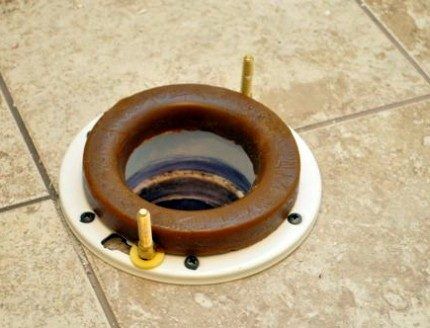
The sealing ring can be lubricated with silicone to prevent unpleasant odors from the sewer from entering the bathroom. Then the toilet is placed on top of the flange and secured with nuts, onto which decorative caps are placed on top. Installation is complete.
Visualize the process connecting a toilet with a vertical flush demonstrated in the video:
#2: Connecting a toilet with a horizontal pipe
Installation of a toilet with a horizontal pipe is similar to that using corrugation, and it can be installed almost flush against the wall.
The difference is that initially a rigid system is installed that will connect the toilet to the sewer riser. The structural elements should not move when the toilet pipe is inserted into it.
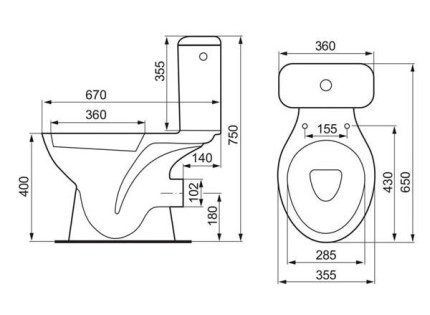
Before installation, you need to try on the toilet and mark the locations for drilling holes for fastenings.After this, remove the plumbing, drill holes, insert dowels and put the toilet back in place, putting the pipe into the sewer hole greased with silicone.
Before screwing in the plumbing, you should perform a test drain and check for leaks.
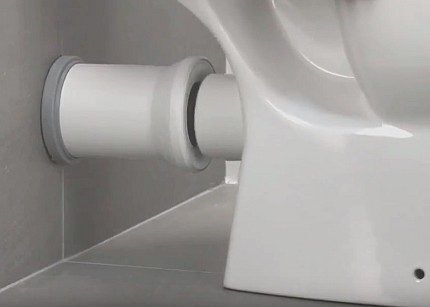
If at the last moment a decision is made to move the toilet slightly to the side, then you can use an additional eccentric adapter, but its length will move the location of the toilet forward. This may require re-drilling the mounting holes.
In domestic apartments, toilets with a horizontal outlet are most often connected to the sewer system using a corrugated adapter, without the use of rigid structures.
A video guide on how to connect a toilet with a horizontal flush to a sewer system will help home craftsmen in their work:
#3: Installation of a toilet with an oblique pipe
Direct connection of a toilet with a straight pipe is not much different from that with a horizontal pipe and corrugation. The basic steps are described in more detail in the corresponding chapters above.
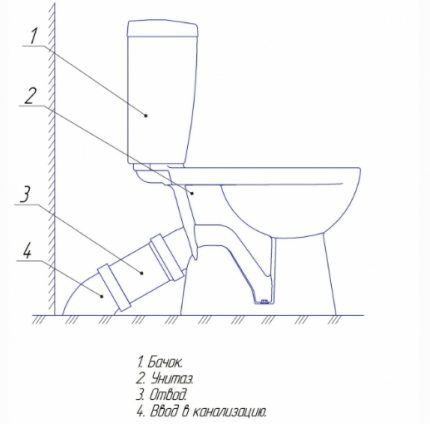
A slanted toilet outlet ensures a lower likelihood of the joint leaking when flushing water, therefore it is more preferable than a horizontal one.A plumbing structure with an oblique outlet is quite difficult to connect to the sewer using corrugations due to the small distance between the floor and the outlet of the pipe.
Instructions for installation of a toilet with an oblique flush using the corrugation will introduce the sequence of actions:
Before installing the sewer system, it is necessary to try on the toilet, mark the places for dowels for screwing the device, and check that the axes of the connected holes are not distorted.
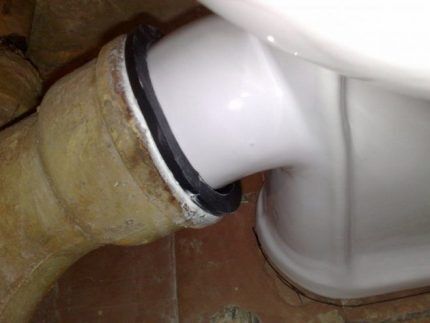
After installing the dowels into the floor, the toilet pipe is placed on a sewer pipe pre-lubricated with silicone and fixed to the floor with screws.
In case of a slight leak, you can lubricate the outer joint with silicone and leave to dry for several hours. After this you can use the toilet.
Conclusions and useful video on the topic
To better understand the instructions described above, it is recommended that you watch the following video review:
It is not difficult to connect the toilet to the sewer system yourself. To do this, it is advisable to buy in advance a model of equipment that will fit most aesthetically into the interior of the bathroom.
With a minimum of tools, sealant and correctly selected connecting parts, you can install the toilet using the above instructions in a few minutes.
Do you have practical skills in installing and connecting a toilet to a sewer? Please share your knowledge, experience with our readers or ask questions. The comment form is located below.




Everyone recommends sealant wherever you spit! This is what causes leaks from your sealant - it peels off over time and begins to leak. The elastic band securely fixes it in a compressed state at all times.
Have you made sure that the elastic band holds well? It gradually shrinks to the diameter of the pipe and cracks after a couple of years. In my bathroom and kitchen the risers are purely on rubber bands, 4 years have passed and they are leaking a little, wet smelly dirt has come out.
It is necessary to lubricate all rubber bands inside the pipes with damper grease, such as PMS-60000. And as a sealant, use polyurethane sealants, which, unlike silicones, do not break down.
In 25 years, my rubber seals have not leaked.
Now everything is being simplified, but with sealant everything is done easily and simply. Nobody really thinks about how this will affect the quality. However, as long as people don’t complain too much, then they will do it that way.
I unknowingly had a bitter experience with the toilet being installed incorrectly. I installed it at a slight forward slope, and then laid the tiles. What happened next was really funny. You understand, nothing was going to wash away, the slope was in the way. We suffered for a couple of months, then we had to carefully beat the tiles along the contour... I came to the conclusion that first we need to measure 7 times, even with the toilet, and maybe especially with it. Your article is useful: it contains a lot of necessary information for the owner. There is no need to contact someone when you can read and do it yourself. The main thing is not to rush!
Hello. How to connect a toilet with an oblique outlet of 30 degrees and a sewer drain of 45 degrees?
An angle (or a 15 degree bend will help you
What to do if the toilet was purchased with an oblique outlet and the sewer pipe is higher than the toilet outlet
Raise the toilet onto a pedestal. An oak board will do.